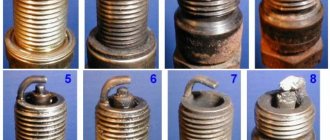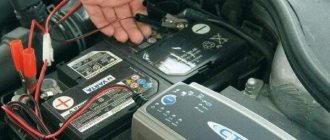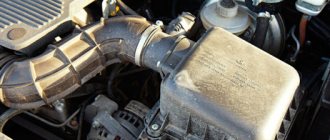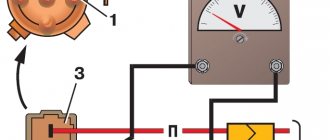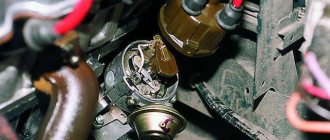The abundance of monitoring and control electronics still does not allow protecting modern injection engines from various malfunctions and problems. Periodically, the engine idles unstable, starts poorly and does not allow you to move away.
You should not always rely solely on electronics, sensors and the car's on-board computer. If, the next time you try to start the internal combustion engine, you clearly hear the fuel pump (pump) working, but the engine itself does not start, you need to check your ignition system to ensure its functionality.
Practice clearly shows that quite often the reason lies in the lack of a spark on the spark plugs. It is with their inspection that experienced motorists and repairmen recommend starting the inspection. Only when deciding to deal with the problem on your own, be extremely careful. There are several methods for checking spark, but each of them requires mandatory compliance with safety rules. Otherwise, you may suffer from an electric shock, as well as damage the car itself.
How to check spark plugs yourself
You can check the presence of a spark and, in general, operability, in several ways:
- Start the engine and pull out the high-voltage wires from the spark plugs one by one. If the spark plug does not work, the sound and vibration of the internal combustion engine will not change. And, if you disconnect the wire from a working spark plug, you will immediately feel changes in the operation of the motor.
- Turn off the engine. Unscrew the spark plug, place the thread on the body, for example, on the valve cover, and a second person turns the ignition key. It is better for the person holding the candle to hold it with rubber gloves or let it go altogether. His task is to see if there is a spark, and what kind of spark it is.
- A special device for checking spark plugs is a pistol. A spark plug is inserted into the gun and it is determined whether there is a spark or not.
- A homemade device for testing candles - a piezo lighter with a wire. Connect the wire from the piezo lighter module to the removed candle and place the piezo lighter block itself on ground, then press the button on the block.
- There is also a pressure test method. But why use all sorts of complicated methods when the first two methods of checking spark plugs are the most effective.
How to check the spark
From time to time you have to check the performance of the spark plugs to find out some of the reasons for unstable operation. There are 3 ways to check spark plug sparks:
- We check for weight.
- We check with an electronic measuring instrument (multimeter).
- Manual mechanical military method of checking spark. The essence of the method is to make a gap of 4 mm. If the spark hits exactly in the middle, then this is a perfectly working spark plug. If with such a gap the spark hits the side, then this is a poorly functioning spark plug.
Signs that you need to check the spark plugs for a spark:
- interruptions at idle speed;
- engine tripping;
- twitching while moving;
- fuel consumption has increased.
Why there is no spark, reasons:
- the candles were flooded;
- broken high-voltage wires;
- contact is broken;
- The crankshaft sensor has failed;
- the ignition module has failed;
- the ignition coil (bobbin) has failed;
- the switch has failed;
- faulty distributor;
- the service life has expired (usually the service life is up to 50 thousand km);
- large layers of soot on the electrodes of the spark plugs (due to low-quality fuel and over-suction);
- presence of oil on the electrodes (excess oil and worn rings);
- varnish and slag deposits on the electrodes (due to various additives in oils and fuels);
- melted candles;
- mechanical damage to the composite spark plug;
- ground contact is poor;
- The electronic control unit (ECU) is not working correctly.
Let's sum it up
Spark plugs play a vital role in the performance of a vehicle. If at least one spark plug fails and does not produce a spark, accordingly, one of the cylinders will not work, the car will have increased fuel consumption and will be less dynamic. Finding the reason for the disappearance of the spark is a very difficult task, since several units may be “to blame” for this. However, for normal functioning this is simply necessary.
Good day everyone) This is the situation: after a short circuit (I removed the voltage regulator because it burned out and the wire touched the body), the spark on the VAZ 2106 disappeared. The ignition is electronic. The ignition coil is working, I checked it on another car. No current flows to the coil. I checked the fuses. What could be the reasons? Maybe the switch, since the red-blue wire that goes from the switch to the coil has melted? The photo shows a melted wire, replaced it.
Checking the spark on the injection engine
Among the common malfunctions of an injection engine or carburetor engine is when the spark is lost on the spark plugs. In this case, the engine may not start or after starting it may function intermittently (triple), since there is no spark at one of the spark plugs and the cylinder actually does not work.
In such a situation, diagnosis should begin with checking the ignition system. In parallel with this, it is worth taking into account certain features and nuances depending on the type of engine installed. Next, we will talk about available ways to check the ignition for spark in relation to engines with a carburetor, and also consider what to do if the spark on an injection engine is lost.
Read in this article
High voltage wires
After the spark plugs have been checked and it turns out that they are not the problem, you need to test to see if anything has happened to the high-voltage wires. Diagnosis is carried out in four simple steps.
- If there is no spark on only one cylinder, swap the wires
- Let's check if the problem is resolved after this action
- If a spark appears on a cylinder, but it disappears on another cylinder, then the problem is definitely in the wire.
- The faulty wire must be replaced with a new one.
Likewise, it would not hurt to check whether the central wire that supplies current to the ignition coil is working properly. Sometimes a spark appears after this wire is pressed harder against the transformer, which is located on the distributor cover.
Why the spark disappears: the main reasons
On different types of engines, there is a fairly wide list of reasons why there is no spark at the spark plugs. Among the main experts are:
- Problems with spark plugs (destruction of the spark plug body, defects in the electrodes, etc.). It is also worth noting that the spark plugs may be filled with fuel or oil, which indicates a breakdown of the engine itself.
- Malfunctions of high-voltage wires associated with insulation breakdown or lack of contact.
- Failure or errors in the operation of the crankshaft position sensor.
- Problems with the ignition module, ignition coil, switch;
- Malfunctions or malfunctions of the distributor.
- Deterioration or absence of ground contact.
- Errors related to the operation of the electronic engine control unit (ECU);
Conclusion
You can simplify the work with spark plugs by following a simple recommendation - change spark plugs according to schedule and service life. This is usually about 30 thousand km for gasoline internal combustion engines.
One of the methods for checking candles on video.
General recommendations for using candles.
When problems with spark plugs appear in cars, this immediately affects the normal operation of the engine, friction appears, and the engine stalls. You can find out whether the problem is really with the spark plugs by externally assessing their condition and checking whether there is a spark.
No spark on an injection engine or an engine with a carburetor: how to check
Checking the spark is possible using several methods: to ground, using a multimeter, or a special tester on a piezoelectric element. The first method is the simplest. The body of the unscrewed spark plug is brought to the metal (usually the engine cylinder block), after which the engine is cranked by the starter and the presence of a spark is analyzed.
Please note that this verification method cannot be used when diagnosing fuel-injected vehicles. The fact is that a car with an injector has an ECU and other electrical equipment that is quite sensitive and can be damaged.
The second method allows you to better assess the condition of the spark plug, identify breakdown, etc. The use of a special tester is a method of checking the spark on injector cars, reminiscent in its principle of checking by analyzing the spark breakdown to ground (the first method). In this case, the risk of burning the control unit is minimized. Now let's talk about how to check the spark on a fuel-injected engine.
A complete lack of sparking indicates possible problems with the controller, ignition module, coil or center wire. Diagnostics should begin by checking the fuses. Then you should evaluate the condition of the ground contact, and also check the high-voltage wires.
If there is no spark at the ignition coil, then the functionality of the high voltage wire should be checked. The specified wire must be checked for insulation integrity, have no breakdowns, burnt areas, etc. Detection of any defects is grounds for its replacement.
Also, in the process of diagnosing the ignition system, you should inspect the spark plugs. This must be done if electricity reaches the candles. On carburetor cars, it is enough to remove the spark plug wire, and then bring it closer to a metal surface (for example, a car body) by half a centimeter. Then you need to turn the starter and make sure that there is a spark running between the wire and the metal surface. The spark itself should also have a certain intensity, be white with a slight bluish tint. If no deviations are noticed, then the spark plugs are working. The reason that there is no spark at the spark plug may be the ignition coil.
If you notice problems with the spark plugs, then you need to pay attention to the spark plug contacts. These contacts must be free of contamination. Let us add that if deviations from the norm are noticed, it is optimal to immediately replace the spark plugs. Failure to do so will indicate the need to clean the contacts.
Bringing the car back to life
As for why a spark disappears, everything is probably very clear. Now, it would not be amiss to consider the order of her return. The reality is that in most cases, getting the spark back is a simple matter and just involves carefully checking the broken car. To be more precise, to normalize sparking it is required:
- Firstly, check the spark on the injector using the method described above, make sure that it has disappeared, and, at least indirectly, try to determine the cause of the malfunction;
- Next, it is enough to assess the current circumstances and act based on them. As typical situations, we suggest considering solutions to the following problems:
- the spark plug is wet, the presence and strength of the spark are unimportant, the carbon deposits are correct (brick color) - wipe the part and screw it back in;
- the spark plug is wet (not always) and the carbon deposits are incorrect (white or black) - clean, dry the part and try to start the engine, if there is no result, change the spark plug and deal with problems in the fuel system (cleaning the injector, checking the ECU, etc.);
- the spark plug is wet, there is no spark at all, the color of the soot is not important - we try to change the part, if there is no result, we check the ignition system and the operation of the injector.
In principle, in theory there are no particular difficulties in repairs of this kind. Despite this, it often causes difficulties in implementation for inexperienced motorists. To solve these, you need to act in the order described above, but if something doesn’t work out, it’s better to turn to professionals at a service station. This approach to repairs will not only save time, but also guarantee trouble-free operation of the car in the future.
Perhaps this concludes the most important information on today’s issue. We hope that the material presented was useful to you and provided answers to your questions. Good luck in operating and maintaining your car!
Checking the ignition coil for spark
To diagnose the performance of the coil, remove the wire from the distributor-breaker. Next, the test is carried out similarly to testing high-voltage wires, that is, the wire is brought to a metal surface and turned with a starter. The presence of a spark will indicate in this case a problem with the ignition distributor; if there is no spark, then the problem lies in the coil.
First you need to check the distributor contacts. These contacts may oxidize, insulation damage is also possible, and the rotor itself may be faulty. Detecting problems with the rotor allows you to eliminate the problem by replacing it. When checking the ignition coil, you should identify possible defects in the integrity of the winding, burnouts and other signs that a short circuit is occurring inside. If such signs are found, the coil should be replaced or the ignition coil should be repaired.
Now let's take a closer look at ways to check the main elements of the ignition system. To do this, let's go back to the coil. As already mentioned, the most common cause of a malfunction is a damaged winding. Then an insulation breakdown occurs and a short circuit occurs. It is also important to understand that the coil can fail due to overload. Such increased loads occur as a result of problematic spark plugs or spark plug wires. For diagnosis you should:
- put the car in a dry parking, repair or other box. You can also use the garage. The main thing is that the humidity is not too high;
- Next, you will need to clean the distributor cover from dirt, after which the specified cover must be removed;
- then you need to turn the engine crankshaft so that the distributor contacts are closed;
- Now you can turn on the ignition and bring the high-voltage wire of the distributor 3-7 mm to ground;
This is interesting: Attackers can gain access to control your car
After evaluating the spark, you can decide whether the ignition coil needs to be replaced. Please note that repairing this element is often impractical. Also, when installing a new spare part, you should strictly adhere to the required polarity. If this is not done, then the new part will quickly become unusable after unqualified installation. Please note that car service centers use a special stand to check coils. Such equipment allows you to check the coil taking into account various operating modes.
To check the spark on the spark plugs if the distributor is working properly and there are no problems with the condition of the high-voltage wires, you need to unscrew the spark plugs from the engine. In addition to the contacts, you should look at carbon deposits, the degree of oiling of the electrodes, etc. For normal sparking, contamination must be cleaned. You should also check the gap between the electrodes, which is usually between 0.7 and 0.9 mm. If the gap is broken, then you can carefully bend the side electrode. This method is a temporary measure, but in some cases it allows you to drive from several tens to hundreds of kilometers without tripping the engine in case of problems with the spark plugs.
We also add that there are special pistol devices for checking spark plugs. Typically, such solutions are available from spark plug sellers in car dealerships or automotive markets. If there is such a possibility, then the spark plugs can be checked on similar equipment.
Checking the Low Voltage Circuit Condition
This is also not a superfluous event when it comes to the absence of a spark on the candles. To carry out such a diagnosis, you will need a test lamp. Moreover, choose a device with a power of 2-3 W and a voltage of 12 V.
One contact from the control unit is connected to the low voltage contact of your distributor, and the second goes directly to ground. Now you need to close the distributor contacts and start the ignition. If there are no problems in the circuit, then at the moment the contact closes, the lamp must go out. In this case, it lights up only when the contacts open.
If, after opening the distributor contacts, nothing happened, that is, the control lamp did not light up, the cause of the malfunction most likely lies in the breakdown of the primary winding of the coil, or in the low voltage wires.
There are situations when the control lamp shines constantly during diagnostics, without interruption, regardless of the opening or closing of the contacts. Here you should consider one of several potential reasons for this behavior of the warning light:
- the contacts on the distributor have oxidized, which need to be frequented and, if possible, lubricated with graphite lubricant;
- the wires that connect the movable disk of the distributor and its body are damaged;
- other wiring located between the distributor terminal and the lever was damaged.
The test should always be carried out in stages, starting from the most likely faults, and ending with those that are much less likely to cause a lack of spark.
Do not rush to make the worst and most unpleasant diagnosis for your ignition system. It often happens that the reason lies in banal carbon deposits on spark plugs or blown fuses.
If there is no spark: ignition module
The following symptoms indicate possible problems with the operation of the ignition module:
- at idle speed the engine troits;
- power decreases, the car accelerates poorly;
Engine vibration is most pronounced in two nearby cylinders, and the drop in thrust is more strongly felt during attempts to sharply accelerate the vehicle, that is, when the accelerator is pressed hard and sharply. In such a situation, the “check” light usually lights up on the dashboard of most cars.
If checking the spark plugs and high-voltage wires does not reveal any problems, then the ignition module should be checked with a tester. The test consists of connecting one output of the tester to the module connector, and powering the other to ground. Then the engine can be started. A tester reading of 12 V is evidence that the module is OK. A deviation in the instrument readings from the norm may indicate either the need to replace the module itself or to check/replace the corresponding fuses.
Useful tips
Experienced car enthusiasts are well aware that spark plugs can fail at the most inopportune moment. For this reason, it is recommended to carry a spare set with you. The same can be said about the spark plug wires.
When working on the ignition system, extreme caution should be exercised as you may receive a severe electric shock. Insulated tools must be used.
Since spark plugs fail more often than other elements of the ignition system, checking for a spark always begins with them. Diagnostics can be done one by one. The procedure is carried out by unscrewing the spark plug from the cylinder head, then putting a cap and a wire from the coil on the spark plug, after which it is grounded to ground. The main indicator when checking while the starter is rotating is the spark itself and its quality.
When removing the spark plug wires from the ignition module, it is advisable to mark each wire. This will allow you to check and subsequently connect in a strictly defined order without the risk of mixing up the wires.
Signs of malfunction and checking injection nozzles without dismantling. Diagnostics of injector power supply, performance analysis. Tips and tricks.
Why does the starter turn normally, but the engine does not catch and does not start? Main causes of malfunction, checking fuel supply and ignition systems. Adviсe.
How to check engine performance using spark plugs. The main signs of engine malfunctions: the appearance of black, gray, red and white carbon deposits on the spark plugs.
Signs of malfunction or breakdown of the high-voltage spark plug wire of the ignition system. How to check car armored wires with your own hands.
Engine trouble: symptoms. Why does tripping occur and how to find the reason why the motor starts to trip. Checking power, ignition, compression, etc.
What does the color of carbon deposits on a spark plug indicate, and why does carbon deposits of one color or another form? How to clean spark plugs from carbon deposits with your own hands, tips.
Main symptoms
The malfunction of these elements can be determined by the nature of the car’s behavior. The main symptoms are difficult ignition, unstable engine operation, floating engine speed at idle. One of the signs of a malfunction is increased fuel consumption. It does not burn in the cylinder because there is no spark. At the same time, the car’s power decreases, since it runs on three (if we consider modern passenger cars) cylinders. Difficulty starting is also the cause of failed spark plugs. The spark may disappear or be completely absent. As a result, the crankshaft rotates, but the ignition power in the remaining cylinders is not enough for its normal operation. Moreover, this occurs even on a warm engine. Sometimes the lack of a spark in one of the cylinders provokes breakdown of the catalyst. The mixture that was prepared and fed into the combustion chamber does not ignite and enters the catalyst, where its elements are oxidized.
Symptoms of a problem
It is almost impossible to visually determine that there are problems with the current supply in the car. To diagnose, you should start the engine or drive the equipment at high speeds.
Before checking the ignition module, you should clearly know the symptoms of the “disease”. So, the first signals about problems with spark plugs:
- The vehicle's crankshaft rotates at the required speed, but the engine does not start. Due to the lack of a spark, there is no ignition of the combustible mixture;
- alternate flashes and fires occur in one or more cylinders, and as a result the engine operates unstable and chaotically;
- The power unit operates when the car starter rotates. When the “trigger” stops rotating, the unit stalls;
- a sharp loss of the machine’s power potential and, as a consequence, increased fuel consumption;
- failure of the catalyst due to a large amount of unburned fuel inside the segment;
- a long process of starting the engine during periods of medium and low outside temperatures. At this time, a large amount of moisture collects on the outer walls, which does not allow the spark of the candle to pass through;
- all kinds of mechanical damage to the spark plug body, which leads to an unstable supply of current to the combustion chamber for ignition.
If there are pronounced black carbon deposits on the spark plug housing, this indicates a malfunction in the power and fuel supply system. Problems with ignition timing can also be caused by worn-out power system wires .
Implications in practice: catalyst
Misfires cause premature failure of the catalyst. The low quality of materials used in the production of the insulator and resistive filler leads to accelerated degradation of the spark plug. Even if its characteristics meet the manufacturer’s requirements at the beginning of operation, over time, the spark energy may not be enough to reliably ignite the air-fuel mixture, resulting in misfires and an increase in the content of unburned fuel in the exhaust gases. Part of the air-fuel mixture burns out in the exhaust manifold and catalyst, which leads to an increase in temperature inside these elements. Overheating leads to failure of the catalytic converter and oxygen sensors installed in the exhaust system.
Diagnostic methods
In many vehicles, access to the ignition system components is free and not cluttered with third-party parts. Therefore, the driver can easily check the spark plugs at the initial stage to ensure they are working properly. The main thing is to maintain consistency and not to confuse them when unscrewing them from the cylinders. Checking the ignition module is always carried out with obligatory observance of the order in relation to the group of cylinders. Mixing will lead to incorrect final conclusions.
Initially, you should turn off the power unit, one by one disconnect the wires from the conductors themselves and the distributor. If the sound does not change when starting the engine, then there is a problem. Otherwise, continue your search further.
Spark test
An ignition tester is the easiest and most affordable way to quickly check the ignition system for functionality. We unscrew each spark plug one by one and, if necessary, wipe or clean it of carbon deposits. Using a special tester probe, we check the gaps between the electrode and the conductor body.
Advice. Each car has its own standard of clearances, which can be found in the operating instructions. If you don’t have such a book, seek advice from a mechanic at your nearest service center or look for information on the Internet.
Next, we apply the conductor to the engine body, most often this is the cylinder head cover. In this way we ensure constant contact in the power supply network. We run the starter for 3 - 5 seconds, look for the presence or absence of a spark. We also remember the color with which it skips, as this is important for further diagnostics. Blue color indicates that the conductor is fully operational, red or another color indicates the presence of a breakdown.
Can it be cleaned?
If there is a characteristic carbon deposit on the electrode and base, this is a sign of engine malfunction. If you simply clean the spark plug and put it back, the carbon deposits will reappear. The color of deposits can indicate many things. This is an incorrectly prepared mixture, the presence of oil in the combustion chamber, etc. By the way, lubricant gets into the cylinder due to existing scuffs or a worn oil scraper ring. Pay attention to this.
Checking with a multimeter
A universal tester or multimeter helps to quickly check the performance of spark plugs. This device is familiar to many car owners who have had to repair their vehicle. The main purpose of using a multimeter is to detect the presence or absence of a short circuit inside the spark plug.
The multimeter is very easy to use; no special experience or skills are required to use it. For diagnostics, unscrew the conductor, connect one terminal to the spark plug thread, and the second to the central output. When voltage is applied, a spark should appear, which will indicate that the part is working, otherwise it must be replaced. Checking spark plugs with a multimeter is the most common diagnostic option at home. If in testing mode the multimeter shows infinite or very high resistance, then the spark plug is considered non-working.
To check the resistance of the spark plug's built-in resistor, set the multimeter switch to 20 kOhm. One probe of the multimeter touches the central electrode, the other touches the contact terminal. The resistance of all candles should be approximately the same with a slight spread. For spark plugs of injection engines, the resistor resistance is about 4 kOhm.
Pistol check
In addition to checking with a multimeter and a special tester, there is also an original method called “gun test”. Its essence is to examine performance under pressure on a special stand. The algorithm is as follows: insert the conductor into the groove, put on the tip, and after fixing, press the trigger of the gun. A green indicator will indicate 100% performance, a yellow indicator will indicate insufficient conductivity, and a red indicator will indicate a faulty spark plug. Despite the invention of such a device, it does not provide 100% confidence in diagnosis, since the pressure in the gun is somewhat different from the pressure inside the cylinder.
This is interesting: How to protect your car from theft?
Diagnostics using a special gun
This is a rather interesting technique. And it is often used for home diagnostics. This requires a special gun to check the spark plugs. This device has been used in global automotive practice for quite a long time. But domestic car enthusiasts began to widely use it relatively recently.
This technique involves testing under special pressure. Algorithm for this operation:
- The candle is placed in a special slot in the gun. Then the cap is attached to it.
- After securely fixing the spark plug, you should pull the trigger of such a pistol. After pressing, the greatest concentration is required.
- If after this pressing a spark is formed and a light appears on the gun itself, it means that the part being tested is operational.
The indicated technique has not gained great popularity among Russian car enthusiasts, since it does not guarantee absolute confidence in the good working conditions of the spark plug. In addition, the test is carried out under pressure. And in a pistol it differs significantly from the pressure in automotive technology. But thanks to this technique, the driver can have absolutely no doubt that the spark plug will break. Moreover, if this fact was determined during the verification process.
Cleaning spark plugs
Many novice car owners are faced with the problem of cleaning spark plugs. Careless handling may damage the product or render it inoperable. When cleaning spark plugs with your own hands, use the following generally accepted methods:
- manual: a metal brush, rags, toothbrush will be useful. Using light movements around the base, we remove carbon deposits, bringing the product to its standard form. If necessary, use a solvent to remove carbon deposits;
- river sand, which can be taken from any beach or pond. Apply a small amount of sand to a rag and gently wipe the base until completely free of waste products;
- The sandblasting machine is used in service centers and repair shops. There, sand is supplied under high pressure, along with compressed air;
- acetone or other rye cleaner. You can purchase it at any auto store or car market;
- Some people use regular Coca-Cola, but its effectiveness has not been conclusively confirmed.
As you can see, checking spark plugs requires very little time, effort and money. Just 10 minutes is enough, and your car will be in full combat readiness. Follow the recommendations of the article, check the color of the spark, then everything will be fine.
Checking the spark on the spark plugs
Let's check for the presence of a spark on the spark plugs of a carburetor engine with contactless or contact ignition systems. A stable strong spark between the electrodes of the spark plugs is the key to normal engine operation in all modes from idle to power. You can visually examine how spark plugs work and what kind of spark is between their electrodes by carrying out a simple check.
Before checking, make sure that the car’s ignition is turned off and the battery terminals are cleaned and have a reliable connection.
The procedure for checking the spark on the spark plugs of a carburetor engine
- We turn out all the spark plugs.
- We connect high-voltage wires to them.
- We connect the threaded parts of the spark plugs with wire.
- We connect the wire to ground.
The connection must be reliable, with unpainted metal parts of the car body.
- An assistant cranks the engine with the starter.
As you scroll, watch the spark plugs. If uninterrupted sparking is observed between the electrodes of the spark plugs, the spark is strong - the ignition system, including the spark plugs, is working properly. Otherwise (the spark plugs work every once in a while, the spark is weak), the faulty element in the ignition system should be identified. See “Checking the Ignition System.”
Notes and additions
— You can check each spark plug individually for the presence of a spark, connecting to them in turn a high-voltage wire from the central terminal of the ignition coil (each spark plug being tested must have a reliable connection to ground - see photo at the beginning of the article). In this case, the spark plugs are checked, and the high-voltage wires and distributor are excluded from their circuits.
More articles on the ignition system
Other breakdowns and their elimination
If the engine does not start when the ignition is turned on, then, first of all, you need to turn off the ignition system and try to start the engine again after a few seconds. If all this does not give any results, perhaps it makes sense to check the correct installation of the spark plugs - it could very well turn out to be incorrect. If all these actions do not produce any results, then the entire system will have to be thoroughly checked. It may also turn out that the cause of the malfunction is in the distributor cap. It must be carefully dismantled and both sides thoroughly checked. In addition, it is necessary to examine the graphite coal - it could well have been worn off. If the cover is worn out, when its surface is cracked or covered with soot, it is better to replace the cover; it cannot be repaired. The same should be done with graphite coal. Attention! All wiring must be well fixed, because if it comes into contact with other components, its insulation will wear out very quickly. A short circuit can occur due to working fluids getting into the wiring. Therefore, when diagnosing the condition of the ignition system, you should pay special attention to the condition of the wiring. If you find moisture on them, you should definitely wipe it off, because this may well be the reason for poor engine starting. If scratches or other mechanical damage are found on the wiring, it must be replaced. If this is not possible yet, you should wrap problem areas with electrical tape. The ignition coil is checked with an ohmmeter. The resistance must be within the specified range, otherwise the coil will have to be replaced. It is highly not recommended to repair the ignition switch on your own. You can only check the contacts and clean them if oxidation is detected.
It is also worth thinking about the switch, because breakdowns in this unit are quite often the cause of incorrect operation of the ignition coils. The switch is checked with a portable lamp. This is done as follows: the wire that comes from the switch terminal is disconnected from the coil, and then its end is connected to the carrier. The other carrying wire is connected to the coil terminal. Then the ignition is turned on and the car starts using the starter. To do this, the crankshaft will have to be rotated a couple of times. If the light in the carrier lights up continuously, it means that the switch is indeed faulty. Then the problem can only be solved by replacing it. It may also happen that all the wiring is working properly, but the pulses still do not arrive at the switch. Most likely, the contactless sensor is faulty here. It is checked with a voltmeter. This is done as follows: with the ignition off, they begin to carefully turn the crankshaft. In this case, you need to monitor the devices. If the sensor is working properly, then their readings will change sharply. If this does not happen, it can be stated that the sensor is faulty, then it must be replaced. Spark plugs are checked with a “spark”. To do this, you need to remove the wire from the spark plug and bring its end to the ground at a distance of 5-6 mm. After this, you should rotate the crankshaft and look at the gap. If a spark is visible, it means that the system itself is working, and all that remains is to change or clean the spark plugs. During this procedure, it will not be possible to do without an assistant who will have to turn the crankshaft. In this way, the distribution system covers can also be checked. The central wire is disconnected from it, and its end is brought to ground, leaving a gap of 5-6 mm. In this case, you also need to rotate the crankshaft. When a strong spark appears, it can be stated that the circuit is operating normally, and the problem may be in the cover or rotor. It is no longer possible to repair the rotor; it can only be replaced. But if the resistor burns out, the problem can be completely solved with a piece of wire. You can use aluminum and copper wire. A jumper is made from it, which is inserted between the contacts of the router. Of course, this measure is temporary, and you should resort to it only when it is not possible to resolve the issue by installing a full-fledged resistor. For example, this can happen while driving. Do not forget also that a piece of inserted wire causes radio interference, which can spread not only in the cabin, but also near it. The reason for the lack of a spark may also be poor contact of the breaker. Poor contact is quite often the cause of cylinder failure. When checking the contacts, you need to ensure that they are in close contact with each other. Any contamination of the contacts with rust or carbon deposits will certainly reduce the tangent area, and this will certainly cause a complete loss of contact. Sometimes the contacts need to be cleaned non-aggressively. A needle file is used for this. You can clean the contacts with a rag. After cleaning the contacts, rotate the crankshaft until they are completely closed. If any contact does not fit tightly, you need to bend its stand. As you can see, a variety of breakdowns in the ignition system can be eliminated on your own. But if you do not feel completely confident in yourself, then it is better to seek help from specialists who will do everything professionally. Video about checking the ignition system:
Post Views: 1,121
